Nazi concentration camps
 Prisoners hauling earth for the construction of the "Russian camp" at Mauthausen
|
From 1933 to 1945, Nazi Germany operated more than a thousand concentration camps[a] on its own territory and in parts of German-occupied Europe.
The first camps were established in March 1933 immediately after Adolf Hitler became Chancellor of Germany. Following the Night of Long Knives in 1934, the concentration camps were run exclusively by the SS via the Concentration Camps Inspectorate and later the SS Main Economic and Administrative Office. Initially, most prisoners were members of the Communist Party of Germany, but as time went on different groups were arrested, including "habitual criminals", "asocials", and Jews. After the beginning of World War II, people from German-occupied Europe were imprisoned in the concentration camps. Following Allied military victories, the camps were gradually liberated in 1944 and 1945, although hundreds of thousands of prisoners died in the death marches.
More than 1,000 concentration camps (including subcamps) were established during the history of Nazi Germany and around 1.65 million people were registered prisoners in the camps at one point. Around a million died during their imprisonment. Many of the former camps have been turned into museums commemorating the victims of the Nazi regime.
Background

The first modern concentration camps were created by the Spanish in 1896 as "reconcentrados" to house Cubans suspected of supporting insurgents during the Cuban War of Independence and the British during the Second Boer War to house Boers to prevent them from supporting the forces of the South African Republic and the Orange Free State. However, early examples of what could be termed "concentration camps" were utilized by the United States during their forced removal of Native Americans to temporarily house Indian tribesmen while it was decided where they would be forced to migrate to. According to historian Dan Stone, concentration camps were "the logical extension of phenomena that had long characterized colonial rule".[3] Although the word "concentration camp" has acquired the connotation of the murder of those detained due to the Nazi concentration camps, the Spanish, British and American camps did not involve systematic murder of those in them. The German Empire also established concentration camps (German: Konzentrationslager), such as the one of Shark Island during the Herero and Namaqua genocide (1904–1907). The death rate of those sent to these camps was 45%, twice that of the British camps.[4] Over time, concentration camps became more severe. The nineteenth-century professionalization of European armies led to "a doctrine of military necessity as justifying extreme violence", including against civilians considered a threat.[5]
During the First World War, eight to nine million prisoners of war were held in prisoner-of-war camps, some of them at locations which were later the sites of Nazi camps, such as Theresienstadt and Mauthausen. Many prisoners held by Germany died as a result of intentional withholding of food and dangerous working conditions in violation of the 1907 Hague Convention.[6] In countries such as France, Belgium, Italy, Austria-Hungary, and Germany, civilians deemed to be of "enemy origin" were denaturalized. Hundreds of thousands were interned and subject to forced labor in harsh conditions.[7] During the Armenian genocide, internment proved deadly to Armenians who were held in temporary camps prior to their deportation into the Syrian Desert.[8] In postwar Germany, Jews from Eastern Europe were incarcerated at and Stargard as "unwanted foreigners".[9]
History
Early camps (1933–1934)
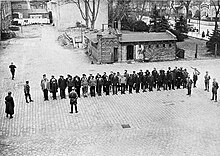

The 1929 economic crash destabilized the Weimar Republic and the last elected government fell in March 1930. A sequence of chancellors appointed by President Paul von Hindenburg governed by rule by decree according to Article 48 of the Weimar Constitution. On 30 January 1933, Adolf Hitler became chancellor after striking a backroom deal with the previous chancellor, Franz von Papen.[10] According to historian Nikolaus Wachsmann, the Nazis had no plan for concentration camps prior to their seizure of power.[11] The concentration camp system arose in the following months due to the desire to suppress tens of thousands of Nazi opponents in Germany. The Reichstag fire in February 1933 was the pretext for mass arrests; the Reichstag Fire Decree eliminated the right to personal freedom enshrined in the Weimar Constitution.[10][12] The first camp was Nohra, established in Nohra, Thuringia on 3 March 1933 in a school.[13] The arrests increased after the election of 5 March.[10]
The legal basis for the arrests was the previous practice of "protective custody", which meant either to restrict a person's liberty for their own protection, or "taking seditious elements into custody during emergencies", including some Communist Party of Germany (KPD) members in the Weimar Republic.[10] Protective custody meant that imprisonment could continue after a person was acquitted or had completed their sentence.[13] Newspapers at that time reported on the concentration camps in considerable detail and demonized the prisoners as dangerous leftist elements.[14] Eighty percent of prisoners were Communists and ten percent Social Democrats; the remaining ten percent were affiliated with a different party, were trade union activists, or had no connection to a political party.[15] By the end of the year, 241 former Reichstag deputies under Weimar had been arrested.[16] Many prisoners were released in late 1933, and after the well-publicized Christmas amnesty, there were only a few dozen camps left.[17]
The number of prisoners in 1933–1934 is difficult to determine; Jane Caplan estimated it at 50,000, with arrests perhaps exceeding 100,000,[13] while Wachsmann estimated that between 150,000 and 200,000 people were subjected to detention without trial in 1933.[12] About 70 camps were established in 1933, in any convenient structure that could hold prisoners, including vacant factories, prisons, country estates, schools, workhouses, and castles. Many sites were reused as Nazi detention facilities later on.[13][12] There was no national system;[17] camps were operated by local police, SS, and SA, state interior ministries, or a combination of the above.[13][12] The early camps in 1933–1934 were heterogenous and unlike those created in and after 1936, in fundamental aspects such as organization, conditions, and the groups imprisoned.[18] Therefore, researchers have begun to call them "early camps" rather than "concentration camps".[18] Although the camps were not sites of routine killings,[12] their unprecedented violence marked the end of the Weimar Republic.[18]
Institutionalization (1934–1937)
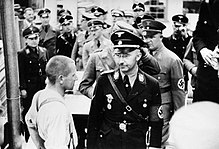
On 26 June 1933, Himmler appointed Theodor Eicke the second commandant of Dachau, which became the model followed by other camps. Eicke drafted the Disciplinary and Penal Code, a manual which specified draconian punishments for disobedient prisoners, including corporal punishment.[19] He also created a system of prisoner functionaries, which later developed into the camp elders, block elders, and kapo of later camps.[20] In May 1934, Lichtenburg camp was taken over by the SS from the Prussian bureaucracy, marking the beginning of a transition set in motion by Heinrich Himmler, then chief of the Gestapo (secret police).[21] Following the Night of Long Knives purge of the SA on 30 June 1934, during which Eicke took a leading role and was promoted for his actions, the remaining SA-run camps were taken over by the SS.[15][22] In December 1934, Eicke was appointed the first inspector of the Concentration Camps Inspectorate (IKL); only camps managed by the IKL were designated "concentration camps".[15] Eicke managed the details of the concentration camps based on Himmler's will.[22]

Wachsmann writes that the "Nazi concentration camp system was forged between 1934 and 1937".[17] In early 1934, the number of prisoners was still falling and the future of concentration camps was not obvious. By mid-1935, there were only five camps, holding 4,000 prisoners, and 13 employees at the central IKL office. At the same time, 100,000 people were imprisoned in German jails, a quarter of those for political offenses.[23] Himmler considered the release of the 1933 prisoners "one of the most serious political mistakes the National Socialist state could have committed". Believing Nazi Germany to be imperiled by internal enemies, he called for a war against the "organized elements of sub-humanity", including Communists, Socialists, Jews, Freemasons, and criminals. Himmler won Hitler's backing and was appointed chief of police on 17 June 1936. Although the Nazi dictator never set foot on a concentration camp, he played a key role in events in 1935, pardoning several guards convicted of the murder of prisoners and backing Himmler's opposition to prisoner releases.[24]
Of the six SS camps operational as of mid-1936, only two (Dachau and Lichtenburg) still existed by 1938. In the place of the camps that closed down, Eicke opened new camps at Sachsenhausen (September 1936) and Buchenwald (July 1937). Unlike earlier camps, the newly opened camps were purpose-built, in Wachsmann's words "planned as small cities of terror". They were designed with barracks, guard towers, and barbed wire. Even Dachau, the model camp, was completely rebuilt in 1937/1938.[25] The new camps were isolated from the population and the rule of law, enabling the SS to exert absolute power. Prisoners, who previously wore civilian clothes, were forced to wear uniforms with Nazi concentration camp badges. The guards for the camps were camp SS or "death's head" SS, young men specifically recruited for the task. The number of prisoners began to rise again, from 4,761 on 1 November 1936 to 7,750 by the end of 1937.[26]
Rapid expansion (1937–1939)
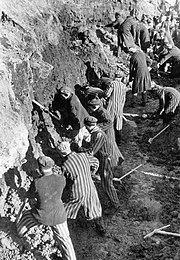
By the end of June 1938, the prisoner population had expanded threefold in the previous six months, to 24,000 prisoners. The increase was fueled by arrests of those considered "habitual criminals" or "asocials".[26] According to SS chief Heinrich Himmler, the "criminal" prisoners at concentration camps needed to be isolated from society because they had committed offenses of a sexual or violent nature. In fact, most of the criminal prisoners were working-class men who had resorted to petty theft to support their families.[27] The asocial category was for people who did not "fit into the mythical national community", in Wachsmann's words.[28] Nazi raids, such as the Aktion Arbeitsscheu Reich of June 1938, in which 10,000 were arrested,[29] targeted homeless people and the mentally ill, as well as the unemployed.[30] Although the Nazis had previously targeted social outsiders, the influx of new prisoners meant that political prisoners became a minority.[29]
To house the new prisoners, three new camps were established: Flossenbürg (May 1938) near the Czechoslovak border, Mauthausen (August 1938) in territory annexed from Austria, and Ravensbrück (May 1939) the first purpose-built camp for female prisoners.[26] The mass arrests were partly motivated by economic factors. Recovery from the Great Depression lowered the unemployment rate, so "work-shy" elements would be arrested to keep others working harder. At the same time, Himmler was also focusing on exploiting prisoners' labor within the camp system. Hitler's architect, Albert Speer, had grand plans for creating monumental Nazi architecture. The SS company German Earth and Stone Works (DEST) was set up with funds from Speer's agency for exploiting prisoner labour to extract building materials. Flossenbürg and Mauthausen had been built adjacent to quarries, and DEST also set up brickworks at Buchenwald and Sachsenhausen.[31][32]
Political prisoners were also arrested in larger numbers, including Jehovah's Witnesses and German émigrés who returned home. Czech and Austrian anti-Nazis were also targeted after the annexation of their countries in 1938 and 1939. Jews were also increasingly targeted, with 2,000 Viennese Jews arrested after the Nazi annexation. After Kristallnacht pogrom, 26,000 Jewish men were deported to concentration camps following mass arrests, becoming a majority of prisoners. These prisoners were subject to unprecedented abuse, including systematic theft of valuables, "deprivation, torture, suicide and murder" leading to hundreds of deaths—more people died at Dachau in the four months after Kristallnacht than in the previous five years. However, the goal at the time was not mass murder of Jews, but to goad them into emigration. Most of the Jewish prisoners were soon released.[33]
World War II
At the end of August 1939, prisoners of Flossenbürg, Sachsenhausen, and other concentration camps were transported to the Polish border, dressed in Polish uniforms, and murdered as part of the Hochlinden incident, one of the false flag attacks staged by Germany to justify the invasion of Poland.[34] During the war, the camps became increasingly brutal and lethal due to the plans of the Nazi leadership: most victims died in the second half of the war.[35]
Five new camps were opened between the start of the war and the end of 1941: Neuengamme (early 1940), outside of Hamburg; Auschwitz (June 1940), which initially operated as a concentration camp for Polish resistance activists; Gross-Rosen (May 1941) in Silesia; and Natzweiler (May 1941) in territory annexed from France. Satellite camps were also established. This expansion was driven by the demand for forced labor and later the invasion of the Soviet Union; new camps were sent up near quarries (Natzweiler and Gross-Rosen) or brickworks (Neuengamme).[36]
In early 1941, the high command of the SS ordered the deliberate mass murder of ill and exhausted prisoners who could no longer work (especially those deemed racially inferior), in an operation codenamed Action 14f13. Victims were selected by camp personnel and traveling "euthanasia doctors" and were removed from the camps to be murdered in euthanasia centers. By spring 1942, when the operation finished, at least 6,000 people had been killed.[37] A related operation, , began in August 1941 and involved the killing of selected Soviet prisoners of war within the concentration camps, usually within a few days of their arrival. By mid-1942, when the operation finished, 38,000 Soviet prisoners had been murdered. At Auschwitz, the SS used Zyklon B to kill Soviet prisoners in improvised gas chambers.[38]
From July 1944 to May 1945 the concentration camps were gradually taken over and the remaining prisoners freed, mostly by Soviet or US forces (see The Holocaust#Liberation).
Organization
This section needs expansion. You can help by . (June 2020) |
In November 1940, the replacement of Eicke by Richard Glücks as leader of the IKL led to a bureaucratic shuffle with little practical consequences: the IKL came under the control of the SS Main Command Office and the Reich Security Main Office (RSHA) took on the responsibility of detaining and releasing concentration camp prisoners.[39] In 1942, the IKL became Amt D (Office D) of the SS Main Economic and Administrative Office (SS-WVHA) under Pohl.[40]
Prisoners
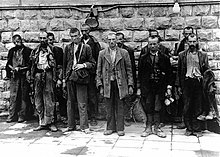
Before World War II, most prisoners in the concentration camps were Germans.[39] After the expansion of Nazi Germany, people from countries occupied by the Wehrmacht were targeted and detained in concentration camps, especially Czechs from the Protectorate of Bohemia and Moravia, Republican veterans of the Spanish Civil War, and Poles.[41][39] In Western Europe, arrests focused on resistance fighters and saboteurs, but in Eastern Europe arrests included mass roundups aimed at the implementation of Nazi population policy and the forced recruitment of workers. This led to a predominance of Eastern Europeans, especially Poles, who made up the majority of the population of some camps. By the end of the war, only 5 to 10 percent of the camp population was "Reich Germans" from Germany or Austria.[39] In late 1941, many Soviet prisoners of war were transferred to special annexes of the concentration camps. Intended as a labor reserve, they were deliberately subject to mass starvation.[42]
Most Jews who were persecuted and killed during the Holocaust were never prisoners in concentration camps, instead being detained at Nazi ghettos or forced-labor camps. However, those who entered the system faced specific harassment (often fatal).[39] Significant numbers of Jews were imprisoned beginning in November 1938 because of Kristallnacht, after which they were always overrepresented as prisoners.[43] After the start of the war, some Jews who had been released after Kristallnacht were arrested again if they had not managed to emigrate.[39]
Jews, Slavic prisoners, and Spanish Republicans were targeted for especially harsh treatment which led to a high mortality rate during the first half of the war. In contrast, Reich Germans enjoyed favorable treatment compared to other nationalities.[39] A minority of prisoners obtained substantially better treatment than the rest because they were prisoner functionaries (mostly Germans) or skilled laborers.[44] Prisoner functionaries served at the whim of the SS and could be dismissed for insufficient strictness. As a result, sociologist Wolfgang Sofsky emphasizes that "They took over the role of the SS in order to prevent SS encroachment" and other prisoners remembered them for their brutality.[45]
Conditions
This section needs expansion. You can help by . (June 2020) |
Forced labor
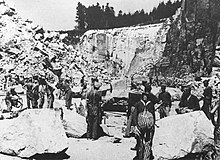
After 1942, many small subcamps were set up near factories to provide forced labor. IG Farben established a synthetic rubber plant in 1942 at Monowitz concentration camp (Auschwitz III); other camps were set up next to airplane factories, coal mines and rocket propellant plants. Conditions were brutal and prisoners were often sent to the gas chambers or killed on site if they did not work quickly enough.[citation needed]
This section needs expansion. You can help by . (June 2020) |
Public perception
There is something of a myth that German people were terrorized into compliance by Nazi totalitarianism. Instead, Robert Gellately argues, "the Germans generally turned out to be proud and pleased that Hitler and his henchmen were putting away certain kinds of people who did not fit in, or who were regarded as ‘outsiders’, ‘asocials’, ‘useless eaters’, or ‘criminals’."[46] Karola Fings writes that demand for SS construction brigades, concentration camp prisoners who worked in bombed German cities, "points to general acceptance of the concentration camps".[47]
Statistics

There were 27 main camps and, according to Nicholas Wachsmann's estimate, more than 1,100 satellite camps.[48] (This is a cumulative figure that counts all the subcamps that existed at one point; Orth estimates the number of subcamps to have been 186 at the end of 1943, 341 or more in June 1944, and at least 662 in January 1945).[49]
Around 1.65 million people were registered prisoners in the camps, of whom, according to Wagner, nearly a million died during their imprisonment.[50] Historian Adam Tooze counts the number of survivors at no more than 475,000, calculating that at least 1.1 million of the registered prisoners must have died. According to his estimate, at least 800,000 of the murdered prisoners were not Jewish.[51] In addition to the registered prisoners who died, a million Jews were gassed upon arriving in Auschwitz concentration camp; including these victims, the total death toll is estimated at 1.8 to more than two million.[52][53] Most of the fatalities occurred during the second half of World War II, including at least a third of the 700,000 prisoners who were registered as of January 1945.[52] In proportional terms, the death rate was highest in 1942 and fell again in 1943 before rising again during the last year of the war; however the increase in the number of prisoners meant that in absolute terms the number of deaths continued to rise.[54]
Extermination camps such as Kulmhof, Belzec, Sobibor, and Treblinka were not part of the concentration camp system, and were operationally separate. These camps maintained only a minimal prisoner population.[55]
Death marches and liberation
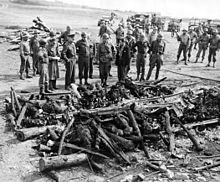
Major evacuations of the camps occurred in mid-1944 from the Baltics and eastern Poland, January 1945 from western Poland and Silesia, and in March 1945 from concentration camps in Germany.[56] Both Jewish and non-Jewish prisoners died in large numbers as a consequence of these death marches.[57]
The camps were liberated by the Allied forces between 1944 and 1945. The first major camp, Majdanek, was discovered by the advancing Soviets on 23 July 1944. Auschwitz was liberated, also by the Soviets, on 27 January 1945; Buchenwald by the Americans on April 11; Bergen-Belsen by the British on 15 April; Dachau by the Americans on 29 April; Ravensbrück by the Soviets on the same day; and Mauthausen by the Americans on 5 May.[58]
In most of the camps discovered by the Soviets, almost all the prisoners had already been removed, leaving only a few thousand alive—7,000 inmates were found in Auschwitz, including 180 children who had been experimented on by doctors.[59] Some 60,000 prisoners were discovered at Bergen-Belsen by the British 11th Armoured Division,[60] 13,000 corpses lay unburied around the camp, and another 13,000 inmates, too weak to recover, died after the camp was liberated.[61] The British forced the remaining SS guards to gather up the corpses and place them in mass graves.[62] After the camp was cleared of both inmates and SS personnel, the British burned down the camp to prevent the spread of typhus.[61]
Many prisoners died after liberation due to their poor physical condition.[63]
Aftermath
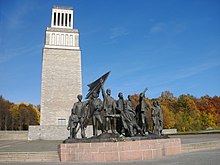
Since their liberation, the Nazi concentration camp system has come to symbolize violence and terror in the modern world.[64] Under the West German policy of Wiedergutmachung (lit. 'making good again'), some survivors of concentration camps received compensation for their imprisonment. A few perpetrators were put on trial after the war.[65]
Many survivors testified about their experiences or wrote memoirs after the war. Some of these accounts have become internationally famous, such as Primo Levi's 1947 book, If This is a Man.[66]
The concentration camps have been the subject of historical writings since Eugen Kogon's 1946 study, ("The SS State").[67][68] However, substantial research did not begin until the 1980s. Scholarship has focused on the fate of groups of prisoners, the organization of the camp system, and aspects such as forced labor.[66] Two comprehensive scholarly encyclopedias of the concentration camps have been published: the German-language Der Ort des Terrors and Encyclopedia of Camps and Ghettos, produced by the United States Holocaust Memorial Museum.[69] According to Caplan and Wachsmann, "more books have been published on the Nazi camps than any other site of detention and terror in history".[70]
Dan Stone argues that the Nazi concentration camp system inspired similar atrocities by other regimes, including the Argentine government during the Dirty War, the Pinochet regime in Chile, and Pitești Prison in the Romanian People's Republic.[71]
Sources
Notes
- ^ German: Konzentrationslager, KL (officially) or KZ (more commonly).[1] The Nazi concentration camps are distinguished from other types of Nazi camps such as forced-labor camps, as well as concentration camps operated by Germany's allies.[2]
Citations
- ^ Wachsmann 2015, p. 635, note 9.
- ^ Stone 2017, p. 50.
- ^ Stone 2017, p. 11.
- ^ Stone 2017, pp. 19–20.
- ^ Stone 2017, p. 22.
- ^ Stone 2017, pp. 23–24.
- ^ Stone 2017, p. 25.
- ^ Stone 2017, p. 28.
- ^ Stone 2017, p. 31.
- ^ Jump up to: a b c d White 2009, p. 3.
- ^ Wachsmann 2009, p. 19.
- ^ Jump up to: a b c d e Buggeln 2015, p. 334.
- ^ Jump up to: a b c d e White 2009, p. 5.
- ^ Fings 2009, pp. 110–111.
- ^ Jump up to: a b c White 2009, p. 8.
- ^ White 2009, p. 9.
- ^ Jump up to: a b c Wachsmann 2009, p. 20.
- ^ Jump up to: a b c Orth 2009a, p. 183.
- ^ White 2009, p. 7.
- ^ White 2009, p. 10.
- ^ Wachsmann 2009, pp. 20–21.
- ^ Jump up to: a b Wachsmann 2009, p. 21.
- ^ Wachsmann 2009, pp. 21–22.
- ^ Wachsmann 2009, p. 22.
- ^ Wachsmann 2009, pp. 22–23.
- ^ Jump up to: a b c Wachsmann 2009, p. 23.
- ^ Wachsmann 2015, pp. 295–296.
- ^ Wachsmann 2015, p. 252.
- ^ Jump up to: a b Wachsmann 2009, p. 24.
- ^ Wachsmann 2015, pp. 253–254.
- ^ Wachsmann 2009, pp. 24–25.
- ^ Orth 2009a, pp. 185–186.
- ^ Wachsmann 2009, pp. 25–26.
- ^ Wachsmann 2015, pp. 342–343.
- ^ Wachsmann 2015, p. 402.
- ^ Wachsmann 2009, p. 27.
- ^ Wachsmann 2009, p. 28.
- ^ Wachsmann 2009, p. 29.
- ^ Jump up to: a b c d e f g Orth 2009a, p. 187.
- ^ Weale 2012, p. 115.
- ^ Stone 2017, pp. 44–45.
- ^ Orth 2009a, p. 188.
- ^ Stone 2017, p. 44.
- ^ Orth 2009a, p. 190.
- ^ Buggeln 2014, p. 160.
- ^ Gellately 2002, p. vii.
- ^ Fings 2008, p. 217.
- ^ Wachsmann 2015, p. 15.
- ^ Orth 2009a, p. 195, fn 49.
- ^ Wagner 2009, p. 127.
- ^ Tooze 2006, p. 523.
- ^ Jump up to: a b Orth 2009a, p. 194.
- ^ Goeschel & Wachsmann 2010, p. 515.
- ^ Buggeln 2014, p. 29.
- ^ Sofsky 2013, p. 12.
- ^ Blatman 2010, p. 9.
- ^ Blatman 2010, p. 10.
- ^ Stone, Dan G.; Wood, Angela (2007). Holocaust: The events and their impact on real people, in conjunction with the USC Shoah Foundation Institute for Visual History and Education. p. 144. ISBN 978-0-7566-2535-1.
- ^ Holocaust: The events and their impact on real people, DK Publishing in conjunction with the USC Shoah Foundation Institute for Visual History and Education, p. 145.
- ^ "The 11th Armoured Division (Great Britain)", United States Holocaust Memorial Museum.
- ^ Jump up to: a b "Bergen-Belsen", United States Holocaust Memorial Museum.
- ^ Wiesel, Elie. After the Darkness: Reflections on the Holocaust, Schocken Books, p. 41.
- ^ Blatman 2010, p. 2.
- ^ Buggeln 2015, p. 333.
- ^ Marcuse 2009, p. 204.
- ^ Jump up to: a b Caplan & Wachsmann 2009, p. 5.
- ^ Blatman 2010, p. 17.
- ^ Caplan & Wachsmann 2009, p. 3.
- ^ Caplan & Wachsmann 2009, pp. 5–6.
- ^ Caplan & Wachsmann 2009, p. 6.
- ^ Stone 2017, p. 81.
Sources
- Blatman, Daniel (2010). The Death Marches: The Final Phase of Nazi Genocide. Harvard University Press. ISBN 978-0-674-05919-1.
- Buggeln, Marc (2014). Slave Labor in Nazi Concentration Camps. Oxford University Press. ISBN 978-0-19-870797-4.
- Buggeln, Marc (2015). "Forced Labour in Nazi Concentration Camps". In De Vito, Christian Giuseppe; Lichtenstein, Alex (eds.). Global Convict Labour. BRILL. pp. 333–360. doi:10.1163/9789004285026_014. ISBN 978-90-04-28501-9.
- Caplan, Jane; Wachsmann, Nikolaus (2009). "Introduction". Concentration Camps in Nazi Germany: The New Histories. Routledge. pp. 1–16. ISBN 978-1-135-26322-5.
- Fings, Karola (2008) [2004]. "Slaves for the 'Home Front': War Society and Concentration Camps". German Wartime Society 1939-1945: Politicization, Disintegration, and the Struggle for Survival. Germany and the Second World War. IX/I. Clarendon Press. pp. 207–286. ISBN 978-0-19-160860-5.
- Fings, Karola (2009). "The public face of the camps". In Caplan, Jane; Wachsmann, Nikolaus (eds.). Concentration Camps in Nazi Germany: The New Histories. Routledge. pp. 108–126. ISBN 978-1-135-26322-5.
- Gellately, Robert (2002). Backing Hitler: Consent and Coercion in Nazi Germany. Oxford University Press. ISBN 978-0-19-160452-2.
- Goeschel, Christian; Wachsmann, Nikolaus (2010). "Before Auschwitz: The Formation of the Nazi Concentration Camps, 1933-9". Journal of Contemporary History. 45 (3): 515–534. doi:10.1177/0022009410366554. S2CID 159866830.
- Marcuse, Harold (2009). "The afterlife of the camps". In Caplan, Jane; Wachsmann, Nikolaus (eds.). Concentration Camps in Nazi Germany: The New Histories. Routledge. pp. 186–211. ISBN 978-1-135-26322-5.
- Orth, Karin (2009a). "The Genesis and Structure of the National Socialist Concentration Camps". In Megargee, Geoffrey P. (ed.). Early Camps, Youth Camps, and Concentration Camps and Subcamps under the SS-Business Administration Main Office (WVHA). Encyclopedia of Camps and Ghettos, 1933–1945. 1. Indiana University Press. pp. 183–196. ISBN 978-0-253-35328-3.
- Orth, Karin (2009b). "The concentration camp personnel". In Caplan, Jane; Wachsmann, Nikolaus (eds.). Concentration Camps in Nazi Germany: The New Histories. Routledge. pp. 44–57. ISBN 978-1-135-26322-5.
- Sofsky, Wolfgang (2013) [1993]. The Order of Terror: The Concentration Camp. Princeton University Press. ISBN 978-1-4008-2218-8.
- Stone, Dan (2017). Concentration Camps: A Very Short Introduction. Oxford University Press. ISBN 978-0-19-103502-9.
- Tooze, Adam (2006). The Wages of Destruction: The Making and Breaking of the Nazi Economy. Allen Lane. ISBN 978-0-7139-9566-4.
- Wachsmann, Nikolaus (2009). "The dynamics of destruction: The development of the concentration camps, 1933–1945". In Caplan, Jane; Wachsmann, Nikolaus (eds.). Concentration Camps in Nazi Germany: The New Histories. Routledge. pp. 17–43. ISBN 978-1-135-26322-5.
- Wachsmann, Nikolaus (2015). KL: A History of the Nazi Concentration Camps. Farrar, Strauss and Giroux. ISBN 978-0-374-11825-9.
- Wagner, Jens-Christian (2009). "Work and extermination in the concentration camps". In Caplan, Jane; Wachsmann, Nikolaus (eds.). Concentration Camps in Nazi Germany: The New Histories. Routledge. pp. 127–148. ISBN 978-1-135-26322-5.
- Weale, Adrian (2012). Army of Evil: A History of the SS. Caliber Printing. ISBN 978-0-451-23791-0.[better source needed]
- White, Joseph Robert (2009). "Introduction to the Early Camps". In Megargee, Geoffrey P. (ed.). Early Camps, Youth Camps, and Concentration Camps and Subcamps under the SS-Business Administration Main Office (WVHA). Encyclopedia of Camps and Ghettos, 1933–1945. 1. Indiana University Press. pp. 3–16. ISBN 978-0-253-35328-3.
Further reading
- Allen, Michael Thad (2002). The Business of Genocide: The SS, Slave Labor, and the Concentration Camps. University of North Carolina Press. ISBN 978-0-8078-2677-5.
- Benz, Wolfgang; Distel, Barbara (eds.). Die Organisation des Terrors [The Organization of Terror]. Der Ort des Terrors (in German). 1. C. H. Beck. ISBN 978-3-406-52960-3.
- Drobisch, Klaus; Wieland, Günther (1993). System der NS-Konzentrationslager: 1933-1939 [The System of Nazi Concentration Camps, 1933–1939] (in German). Akademie Verlag. doi:10.1515/9783050066332. ISBN 978-3-05-000823-3.
- Goeschel, Christian; Wachsmann, Nikolaus (2012). The Nazi Concentration Camps, 1933-1939: A Documentary History. University of Nebraska Press. ISBN 978-0-8032-2782-8.
- Knowles, Anne Kelly; Jaskot, Paul B.; Blackshear, Benjamin Perry; De Groot, Michael; Yule, Alexander (2014). "Mapping the SS Concentration Camps". In Steiner, Erik B. (ed.). Geographies of the Holocaust. Indiana University Press. ISBN 978-0-253-01211-1. JSTOR j.ctt16gzbvn.
- Orth, Karin (1999). Das System Der Nationalsozialistischen Konzentrationslager: Eine Politische Organisationsgeschichte [The National Socialist Concentration Camp System: A Political Organizational History] (in German). Hamburger Edition. ISBN 978-3-930908-52-3.
- Stone, Dan (2015). The Liberation of the Camps: The End of the Holocaust and Its Aftermath. Yale University Press. ISBN 978-0-300-21603-5.
- Suderland, Maja (2013). Inside Concentration Camps: Social Life at the Extremes. John Wiley & Sons. ISBN 978-0-7456-7955-6.
- Wünschmann, Kim (2015). Before Auschwitz: Jewish Prisoners in the Prewar Concentration Camps. Harvard University Press. ISBN 978-0-674-42558-3.
External links
 Media related to Nazi concentration camps at Wikimedia Commons
Media related to Nazi concentration camps at Wikimedia Commons
- Nazi concentration camps
- Holocaust locations
- SS Main Economic and Administrative Office
- Total institutions